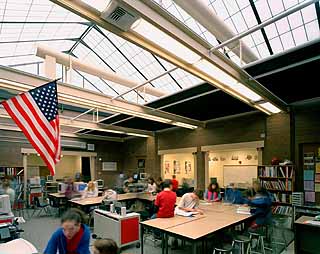|
Subscribe / Renew |
|
|
Contact Us |
|
| ► Subscribe to our Free Weekly Newsletter | |
| home | Welcome, sign in or click here to subscribe. | login |
Construction
| |
 |
September 22, 2005
How to meet new state rules and provide real value
Bassetti Architects

Hepp
|
Washington states's new High-Performance Public Buildings Act can be of substantial value to school districts.
Gov. Christine Gregoire signed legislation in April making Washington the first state to require state-funded building projects to meet standards for sustainable building design and construction. The provisions for school facilities call for a three-year phased implementation beginning in May of 2006.
At the same time, the state enacted a new budget that increases the amounts the state will fund for school construction. The budget also allocates $6.5 million in incentives to encourage voluntary projects during the first phase of implementation.
K-12 schools can comply by earning a minimum number of credit points in either the Leadership in Energy and Environmental Design (LEED) standard or the Washington Sustainable Schools (WSS) protocol. Both are checklists of performance measures and building elements. The elements are grouped in categories of site and water, energy use, materials and indoor environmental quality.
LEED is a general standard, originally developed for office buildings. As a member of the committee that crafted the WSS, I worked to make sure our state's protocol incorporates sustainable strategies that provide long-term value to school communities and support the educational process.

Photo by Doug Scott Photography
Maplewood K-8 Co-op in Edmonds uses insulated skylights in its project areas and light shelves in the classrooms. Experts say such daylighting strategies save energy and improve student test scores.
|
Simply following either checklist can get you to compliance, but it tends to be a costly and piecemeal process. Maximizing benefits begins with a design team that thoroughly understands sustainable design, integrates multiple strategies and has the experience to assess the practical application of each strategy to a particular project.
Benefit-based design
A benefit-based approach to sustainable design incorporates elements that benefit the education environment, decrease long-term costs, or both.
An early example is Mukilteo's Fairmount Elementary, designed in 1985, which incorporates roof monitors to provide natural daylighting within school spaces while reducing electrical costs.
Similar benefits were the driver for the daylighting strategies at the Maplewood K-8 Co-op School in Edmonds, designed in 1998. This example used insulated skylights in its project areas and light shelves in the classrooms.
The educational advantage of daylighting was soon validated by the 1999 Heshong-Mahone study showing a positive correlation between good daylighting and higher test scores.
Maplewood also demonstrates environmentally sensitive site design. Storm water is collected and transported in surface channels through garden areas that cleanse the water, allow infiltration and provide educational opportunities that have been integrated into the curriculum.
Cost-saving improvements
To achieve better air quality in teaching and learning areas, the 1996 specifications for Edmonds-Woodway High School included provisions for paints, building materials and adhesives that emit minimal levels of volatile organic compounds.
Indoor-air quality has become a significant concern as Americans spend more of their time indoors. In schools, better air quality is linked to fewer absences and more alert students.
In the Seattle School District, the modernization of Madison Middle School conserved a significant amount of building materials by reusing major portions of the existing building.
The modernized campus, which opened this fall, uses geothermal energy for heating and cooling. Instead of standard air-to-air heat pumps, water source heat pumps work at high efficiency by moving the process water through underground pipes where the earth's temperature brings the water to a consistent 55 degrees.
In winter, the 55-degree water provides more heat energy than the cold outside air would provide. In summer, that same 55-degree water provides more cooling energy than the outside air on a warm day. The money saved on energy costs can be used to improve educational opportunities.
In all of these cases, strategies were selected and implemented based on individual site and building conditions.
The new legislation makes it even more important to take this approach to all the categories of sustainable design. In so doing, we have an opportunity to integrate strategies, deriving multiple benefits as well as gaining points toward satisfying the regulations.
Integrated design
Integrated design is the term being used for this focus on multiple strategies that act in concert to provide long-term benefits with a high return on investment.
An example of this approach is the new classroom building at Northshore School District's Cottage Lake Elementary, which opened this fall. The building uses 2-by-12-foot "skylight chimneys" that integrate natural light and ventilation into one element.
The electric lighting dims automatically to capture energy savings when the daylight is bright. Abundant fresh air flows into the classrooms without the use of fan energy.
Predicted energy use is 32 percent less than code, which earned an incentive payment of $1.20 per square foot from Puget Sound Energy.
On the Cottage Lake site, the runoff water from parking lots travels through a filtration zone of plants and into a gravel lens before percolating into the native soils. This "rain garden" system saved over $90,000 in construction costs compared with a conventional structured drain and pipe system. It also provides opportunities for kids to learn about water quality and groundwater recharge.
The school district worked with Bassetti Architects to identify strategies and design Cottage Lake to provide energy savings, enhance learning and be easily maintained. As part of a statewide pilot program, we evaluated the building with the WSS protocol. It passed easily, validating our integrated, benefit-based approach to sustainable design.
By using integrated design early in the process, projects can comply with the regulations and provide real value to the community. The increased state match amounts should offset any additional costs associated with the high performance features that enhance learning environments and reduce energy use.
A principal with Bassetti Architects, Greg Hepp leads the firm's sustainable design efforts. He has completed over 30 educational projects and is on the statewide committee that developed and monitors the Washington Sustainable Schools protocol.
Other Stories:
- Softening the landing for college freshmen
- Small schools best prepared to teach the new '3 R's'
- Communities play larger role in shaping schools
- Schools districts discover the value of sustainability
- Top concern of every school staff: air quality
- New schools teach lessons on technology design
- Why process isn't a dirty word


